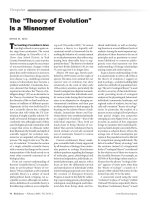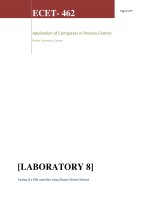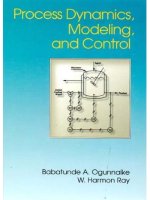Design of Experiments in Chemical Engineering pptx
Bạn đang xem bản rút gọn của tài liệu. Xem và tải ngay bản đầy đủ của tài liệu tại đây (3.22 MB, 523 trang )
Z
ˇ
ivorad R. Lazic
´
Design of Experiments
in Chemical Engineering
Design of Experiments in Chemical Engineering.Z
ˇ
ivorad R. Lazic
´
Copyright 2004 WILEY-VCH Verlag GmbH & Co. KGaA, Weinheim
ISBN: 3-527-31142-4
Further Titles of Interest:
Wiley-VCH (Ed.)
Ullmann’s Chemical Engineering and Plant Design
2 Volumes
2004, ISBN 3-527-31111-4
Wiley-VCH (Ed.)
Ullmann’s Processes and Process Engineering
3 Volumes
2004, ISBN 3-527-31096-7
R. Sundmacher, A. Kienle (Eds.)
Reactive Destillation
Status and Future Directions
2003, ISBN 3-527-30579-3
A. R. Paschedag
CFD in der Verfahrenstechnik
Allgemeine Grundlagen und mehrphasige Anwendungen
2004, ISBN 3-527-30994-2
Z
ˇ
ivorad R. Lazic
´
Design of Experiments
in Chemical Engineering
A Practical Guide
Z
ˇ
ivorad R. Lazic
´
Lenzing Fibers Corporation
1240 Catalonia Ave
Morristown, TN 37814
USA
&
All books published by Wiley-VCH are carefully
produced. Nevertheless, author and publisher do not
warrant the information contained in these books,
including this book, to be free of errors. Readers are
advised to keep in mind that statements, data, illustra-
tions, procedural details or other items may inadver-
tently be inaccurate.
Library of Congress Card No. applied for.
British Library Cataloguing-in-Publication Data:
A catalogue record for this book is available from the
British Library.
Bibliographic information published by
Die Deutsche Bibliothek
Die Deutsche Bibliothek lists this publication
in the Deutsche Nationalbibliografie; detailed
bibliographic data is available in the Internet at
<>.
2004 WILEY-VCH Verlag GmbH & Co. KGaA,
Weinheim
Printed on acid-free paper.
All rights reserved (including those of translation
into other languages). No part of this book may be
reproduced in any form – by photoprinting, micro-
film, or any other means – nor transmitted or trans-
lated into machine language without written permis-
sion from the publishers. Registered names, trade-
marks, etc. used in this book, even when not
specifically marked as such, are not to be considered
unprotected by law.
Composition Kühn & Weyh, Satz und Medien,
Freiburg
Printing Strauss GmbH, Mörlenbach
Bookbinding Litges & Dopf Buchbinderei GmbH,
Heppenheim
Printed in the Federal Republic of Germany.
ISBN 3-527-31142-4
To Anica, Neda and Jelena
Design of Experiments in Chemical Engineering.Z
ˇ
ivorad R. Lazic
´
Copyright 2004 WILEY-VCH Verlag GmbH & Co. KGaA, Weinheim
ISBN: 3-527-31142-4
Preface IX
I Introduction to Statistics for Engineers 1
1.1 The Simplest Discrete and Continuous Distributions 7
1.1.1 Discrete Distributions 10
1.1.2 Continuous Distribution 13
1.1.3 Normal Distributions 16
1.2 Statistical Inference 22
1.2.1 Statistical Hypotheses 23
1.3 Statistical Estimation 30
1.3.1 Point Estimates 31
1.3.2 Interval Estimates 33
1.3.3 Control Charts 42
1.3.4 Control of Type II error-b 44
1.3.5 Sequential Tests 46
1.4 Tests and Estimates on Statistical Variance 52
1.5 Analysis of Variance 63
1.6 Regression analysis 120
1.6.1 Simple Linear Regression 121
1.6.2 Multiple Regression 136
1.6.3 Polynomial Regression 140
1.6.4 Nonlinear Regression 144
1.7 Correlation Analysis 146
1.7.1 Correlation in Linear Regression 148
1.7.2 Correlation in Multiple Linear Regression 152
II Design and Analysis of Experiments 157
2.0 Introduction to Design of Experiments (DOE) 157
2.1 Preliminary Examination of Subject of Research 166
2.1.1 Defining Research Problem 166
2.1.2 Selection of the Responses 170
2.1.3 Selection of Factors, Levels and Basic Level 185
2.1.4 Measuring Errors of Factors and Responses 191
VII
Contents
Design of Experiments in Chemical Engineering.Z
ˇ
ivorad R. Lazic
´
Copyright 2004 WILEY-VCH Verlag GmbH & Co. KGaA, Weinheim
ISBN: 3-527-31142-4
2.2 Screening Experiments 196
2.2.1 Preliminary Ranking of the Factors 196
2.2.2 Active Screening Experiment-Method of Random Balance 203
2.2.3 Active Screening Experiment Plackett-Burman Designs 225
2.2.3 Completely Randomized Block Design 227
2.2.4 Latin Squares 238
2.2.5 Graeco-Latin Square 247
2.2.6 Youdens Squares 252
2.3 Basic Experiment-Mathematical Modeling 262
2.3.1 Full Factorial Experiments and Fractional Factorial Experiments 267
2.3.2 Second-order Rotatable Design (Box-Wilson Design) 323
2.3.3 Orthogonal Second-order Design (Box-Benken Design) 349
2.3.4 D-optimality, B
k
-designs and Hartleys Second-order Designs 363
2.3.5 Conclusion after Obtaining Second-order Model 366
2.4 Statistical Analysis 367
2.4.1 Determination of Experimental Error 367
2.4.2 Significance of the Regression Coefficients 374
2.4.3 Lack of Fit of Regression Models 377
2.5 Experimental Optimization of Research Subject 385
2.5.1 Problem of Optimization 385
2.5.2 Gradient Optimization Methods 386
2.5.3 Nongradient Methods of Optimization 414
2.5.4 Simplex Sum Rotatable Design 431
2.6 Canonical Analysis of the Response surface 438
2.7 Examples of Complex Optimizations 443
III Mixture Design “Composition-Property” 465
3.1 Screening Design “Composition-Property” 465
3.1.1 Simplex Lattice Screening Designs 469
3.1.2 Extreme Vertices Screening Designs 473
3.2 Simplex Lattice Design 481
3.3 Scheffe Simplex Lattice Design 484
3.4 Simplex Centroid Design 502
3.5 Extreme Vertices Designs 506
3.6 D-optimal Designs 521
3.7 Draper-Lawrence Design 529
3.8 Factorial Experiments with Mixture 540
3.9 Full Factorial Combined with Mixture Design-Crossed Design 543
Appendix 567
A.1 Answers to Selected Problems 567
A.2 Tables of Statistical Functions 589
Index 607
ContentsVIII
IX
The last twenty years of the last millennium are characterized by complex automati-
zation of industrial plants. Complex automatization of industrial plants means a
switch to factories, automatons, robots and self adaptive optimization systems. The
mentioned processes can be intensified by introducing mathematical methods into
all physical and chemical processes. By being acquainted with the mathematical
model of a process it is possible to control it, maintain it at an optimal level, provide
maximal yield of the product, and obtain the product at a minimal cost. Statistical
methods in mathematical modeling of a process should not be opposed to tradi-
tional theoretical methods of complete theoretical studies of a phenomenon. The
higher the theoretical level of knowledge the more efficient is the application of sta-
tistical methods like design of experiment (DOE).
To design an experiment means to choose the optimal experiment design to be
used simultaneously for varying all the analyzed factors. By designing an experi-
ment one gets more precise data and more complete information on a studied phe-
nomenon with a minimal number of experiments and the lowest possible material
costs. The development of statistical methods for data analysis, combined with de-
velopment of computers, has revolutionized the research and development work in
all domains of human activities.
Due to the fact that statistical methods are abstract and insufficiently known to all
researchers, the first chapter offers the basics of statistical analysis with actual exam-
ples, physical interpretations and solutions to problems. Basic probability distribu-
tions with statistical estimations and with testings of null hypotheses are demon-
strated. A detailed analysis of variance (ANOVA) has been done for screening of fac-
tors according to the significances of their effects on system responses. For statisti-
cal modeling of significant factors by linear and nonlinear regressions a sufficient
time has been dedicated to regression analysis.
Introduction to design of experiments (DOE) offers an original comparison be-
tween so-called classical experimental design (one factor at a time-OFAT) and statis-
tically designed experiments (DOE). Depending on the research objective and sub-
ject, screening experiments (preliminary ranking of the factors, method of random
balance, completely randomized block design, Latin squares, Graeco-Latin squares,
Youdens squares) then basic experiments (full factorial experiments, fractional fac-
Preface
Design of Experiments in Chemical Engineering.Z
ˇ
ivorad R. Lazic
´
Copyright 2004 WILEY-VCH Verlag GmbH & Co. KGaA, Weinheim
ISBN: 3-527-31142-4
Preface
torial experiments) and designs of second order (rotatable, D-optimality, orthogonal,
B-designs, Hartleys designs) have been analyzed.
For studies with objectives of reaching optima, of particular importance are the
chapters dealing with experimental attaining of an optimum by the gradient method
of steepest ascent and the nongradient simplex method. In the optimum zone up to
the response surface, i.e. response function, one can reach it by applying second-
order designs. By elaborating results of second-order design one can obtain square
regression models the analysis of which is shown in the chapter on canonical analy-
sis of the response surface.
The third section of the book has been dedicated to studies in the mixture design
field. The methodology of approaching studies has been kept in this field too. One
begins with screening experiments (simplex lattice screening designs, extreme ver-
tices designs of mixture experiments as screening designs) through simplex lattice
design, Scheffe's simplex lattice design, simplex centroid design, extreme vertices
design, D-optimal design, Draper-Lawrence design, full factorial mixture design,
and one ends with factorial designs of process factors that are combined with mix-
ture design so-called "crossed" designs.
The significance of mixture design for developing new materials should be partic-
ularly stressed. The book is meant for all experts who are engaged in research, devel-
opment and process control.
Apart from theoretical bases, the book contains a large number of practical exam-
ples and problems with solutions. This book has come into being as a product of
many years of research activities in the Military Technical Institute in Belgrade. The
author is especially pleased to offer his gratitude to Prof. Dragoljub V. Vukovic
´
,
Ph.D., Branislav Djukic
´
, M.Sc. and Paratha Sarathy, B.Sc. For technical editing of
the manuscript I express my special gratitude to Predrag Jovanic
´
, Ph.D., Drago
Jaukovic
´
, B.Sc., Vesna Lazarevic
´
, B.Sc., Stevan Rakovic
´
, machine technician,
Dus
ˇ
anka Glavac
ˇ
, chemical technician and Ljiljana Borkovic.
Morristown, February 2004 Z
ˇ
ivorad Lazic
´
X
1
Natural processes and phenomena are conditioned by interaction of various factors.
By dealing with studies of cause-factor and phenomenon-response relationships,
science to varying degrees, has succeeded in penetrating into the essence of phe-
nomena and processes. Exact sciences can, by the quality of their knowledge, be
ranked into three levels. The top level is the one where all factors that are part of an
observed phenomenon are known, as well as the natural law as the model by which
they interact and thus realize the observed phenomenon. The relationship of all fac-
tors in natural-law phenomenon is given by a formula-mathematical model. To give
an example, the following generally known natural laws can be cited:
E ¼
mw
2
2
; F ¼ ma ; S ¼ vt ; U ¼ IR ; Q ¼ FW
The second group, i.e. at a slightly lower level, is the one where all factors that are
part of an observed phenomenon are known, but we know or are only partly aware
of their interrelationships, i.e. influences. This is usually the case when we are faced
with a complex phenomenon consisting of numerous factors. Sometimes we can
link these factors as a system of simultaneous differential equations but with no so-
lutions to them. As an example we can cite the Navier-Stokes’ simultaneous system
of differential equations, used to define the flow of an ideal fluid:
r
DW
X
@X
¼
@p
@x
þ l r
2
W
X
þ
1
3
@Q
f
@X
r
DW
y
@y
¼
@p
@y
þ l r
2
W
y
þ
1
3
@Q
f
@y
r
DW
z
@z
¼
@p
@z
þ l r
2
W
z
þ
1
3
@Q
f
@z
8
>
>
>
>
>
>
>
<
>
>
>
>
>
>
>
:
An an even lower level of knowledge of a phenomenon is the case when only a
certain number of factors that are part of a phenomenon are known to us, i.e. there
exists a large number of factors and we are not certain of having noticed all the vari-
ables. At this level we do not know the natural law, i.e. the mathematical model by
which these factors act. In this case we use experiment (empirical research) in order
to reach the noticed natural law.
I
Introduction to Statistics for Engineers
Design of Experiments in Chemical Engineering.Z
ˇ
ivorad R. Lazic
´
Copyright 2004 WILEY-VCH Verlag GmbH & Co. KGaA, Weinheim
ISBN: 3-527-31142-4
I Introduction to Statistics for Engineers
As an example of this level of knowledge about a phenomenon we can cite the
following empirical dependencies Darcy-Weisbah’s law on drop of fluid pressure
when flowing through a pipe [1]:
Dp ¼ k
L
D
r
W
2
2
Ergun’s equation on drop of fluid pressure when flowing through a bed of solid
particles [1]:
Dp
H
¼ 150
1e
e
3
2
lf
d
2
p
W þ1:75
1e
e
2
rf
W
2
d
p
The equation defining warming up or cooling of fluid flows inside or outside a
pipe without phase changes [1]:
a
cG
cl
k
0:67
LH
D
0:33
lST
l
0:14
¼ 1:86 =
DG
l
0:67
The first case is quite clear: it represents deterministic and functional laws, while
the second and third levels are examples of stochastic phenomena defined by sto-
chastic dependencies. Stochastic dependency, i.e. natural law is not expressed in in-
dividual cases but it shows its functional connection only when these cases are ob-
served as a mass. Stochastic dependency, thus, contains two concepts: the function
discovered in a mass of cases as an average, and smaller or greater deviations of in-
dividual cases from that relationship.
The lowest level in observing a phenomenon is when we are faced with a totally
new phenomenon where both factors and the law of changes are unknown to us,
i.e. outcomes-responses of the observed phenomenon are random values for us.
This randomness is objectively a consequence of the lack of ability to simultaneously
observe all relations and influences of all factors on system responses. Through its
development science continually discovers new connections, relationships and fac-
tors, which brings about shifting up the limits between randomness and lawfulness.
Based on the mentioned analysis one can conclude that stochastic processes are
phenomena that are neither completely random not strictly determined, i.e. random
and deterministic phenomena are the left and right limits of stochastic phenomena.
In order to find stochastic relationships the present-day engineering practice uses,
apart from others, experiment and statistical calculation of obtained results.
Statistics, the science of description and interpretation of numerical data, began
in its most rudimentary form in the census and taxation of ancient Egypt and Baby-
lon. Statistics progressed little beyond this simple tabulation of data until the theo-
retical developments of the eighteenth and nineteenth centuries. As experimental
science developed, the need grew for improved methods of presentation and analy-
sis of numerical data.
The pioneers in mathematical statistics, such as Bernoulli, Poisson, and Laplace,
had developed statistical and probability theory by the middle of the nineteenth cen-
tury. Probably the first instance of applied statistics came in the application of prob-
ability theory to games of chance. Even today, probability theorists frequently choose
2
I Introduction to Statistics for Engineers
a coin or a deck of cards as their experimental model. Application of statistics in
biology developed in England in the latter half of the nineteenth century. The first
important application of statistics in the chemical industry also occurred in a factory
in Dublin, Ireland, at the turn of the century. Out of the need to approach solving
some technological problems scientifically, several graduate mathematicians from
Oxford and Cambridge, including W. S. Gosset, were engaged. Having accepted the
job in l899, Gosset applied his knowledge in mathematics and chemistry to control
the quality of finished products. His method of small samples was later applied in
all fields of human activities. He published his method in 1907 under the pseudo-
nym “Student”, known as such even these days. This method had been applied to a
limited level in industry up to 1920. Larger applications were registered during
World War Two in military industries. Since then statistics and probability theory
are being applied in all fields of engineering.
With the development of electronic computers, statistical methods began to thrive
and take an ever more important role in empirical researches and system optimization.
Statistical methods of researching phenomena can be divided into two basic
groups. The first one includes methods of recording and processing-description of
variables of observed phenomena and belongs to Descriptive statistics. As a result of
applying descriptive statistics we obtain numerical information on observed phe-
nomena, i.e. statistical data that can be presented in tables and graphs. The second
group is represented by statistical analysis methods the task of which is to clarify the
observed variability by means of classification and correlation indicators of statistic
series. This is the field of that Inferential statistics, however, cannot be strictly set
apart from descriptive statistics.
The subject of statistical researches are the Population (universe, statistical masses,
basic universe, completeness) and samples taken from a population. The population
must be representative of a collection of a continual chemical process by some fea-
tures, i.e. properties of the given products. If we are to find a property of a product,
we have to take out a sample from a population that, by mathematical statistics the-
ory is usually an infinite gathering of elements-units.
For example, we can take each hundredth sample from a steady process and
expose it to chemical analysis or some other treatment in order to establish a certain
property (taking a sample from a chemical reactor with the idea of establishing the
yield of chemical reaction, taking a sample out of a rocket propellant with the idea
of establishing mechanical properties such as tensile strength, elongation at break,
etc.). After taking out a sample and obtaining its properties we can apply descriptive
statistics to characterize the sample. However, if we wish to draw conclusions about
the population from the sample, we must use methods of statistical inference.
What can we infer about the population from our sample? Obviously the sample
must be a representative selection of values taken from the population or else we
can infer nothing. Hence, we must select a random sample.
A random sample is a collection of values selected from a population of values in
such a way that each value in the population had an equal chance of being selected
Often the underlying population is completely hypothetical. Suppose we make
five runs of a new chemical reaction in a batch reactor at constant conditions, and
3
I Introduction to Statistics for Engineers
then analyze the product. Our sample is the data from the five runs; but where is
the population? We can postulate a hypothetical population of “all runs made at
these conditions now and in the future”. We take a sample and conclude that it will
be representative of a population consisting of possible future runs, so the popula-
tion may well be infinite.
If our inferences about the population are to be valid, we must make certain that
future operating conditions are identical with those of the sample.
For a sample to be representative of the population, it must contain data over the
whole range of values of the measured variables. We cannot extrapolate conclusions
to other ranges of variables. A single value computed from a series of observations
(sample) is called a “statistic”.
Mean, median and mode as measures of location
By sample mean X we understand the value that is the arithmetic average of prop-
erty values X
1
; X
2
; X
3
;;X
i
. When we say average, we are frequently referring to the
sample mean, which is defined as the sum of all the values in the sample divided by
the number of values in the sample. A sample mean-average is the simplest and
most important of all data measures of location.
X ¼
X
X
i
n
(1.1)
where:
X is the sample mean-average of the n-values,
X
i
is any given value from the sample.
The symbol
X is the symbol used for the sample mean. It is an estimate of the
value of the mean of the underlying population, which is designated l. We can
never determine l exactly from the sample, except in the trivial case where the sam-
ple includes the entire population but we can quite closely estimate it based on sam-
ple mean. Another average that is frequently used for measures of location is the
median. The median is defined as that observation from the sample that has the
same number of observations below it as above it. Median is defined as the central
observation of a sample where values are in the array by sizes.
A third measure of location is the mode, which is defined as that value of the mea-
sured variable for which there are the most observations. Mode is the most probable
value of a discrete random variable, while for a continual random variable it is the
random variable value where the probability density function reaches its maximum.
Practically speaking, it is the value of the measured response, i.e. the property that
is the most frequent in the sample. The mean is the most widely used, particularly
in statistical analysis. The median is occasionally more appropriate than the mean
as a measure of location. The mode is rarely used. For symmetrical distributions,
such as the Normal distribution, the mentioned values are identical.
4
I Introduction to Statistics for Engineers
Example 1.1 [2]
As an example of the differences among the three measures of location, let us con-
sider the salary levels in a small company. The annual salaries are:
President 50.000
Salesman 15.000
Accountant 8.000
Foreman 7.000
Two technicians, each 6.000
Four workmen, each 4.000
If the given salaries are put in the array we get:
4:000; 4:000; 4:000; 4:000
|fflfflfflfflfflfflfflfflfflfflfflfflfflfflfflfflfflfflfflfflffl{zfflfflfflfflfflfflfflfflfflfflfflfflfflfflfflfflfflfflfflfflffl}
mode
; 6:000
|fflffl{zfflffl}
median
; 6:000; 7:000; 8:000; 15:000; 50:000
During salary negotiations with the company union, the president states that the
average salary among the 10 employees is 9000$/yr, and there is certainly no need
for a raise. The union representative states that there is a great need for a raise
because over half of the employees are earning 6000$ or less, and that more men
are making 4000$ than anything else. Clearly, the president has used the mean; and
the union, the median and mode.
Measures of variability, the range, the mean deviation and variance
As we can see, mean or average, median and mode are measure of Location. Having
determined the location of our data, we mightnextask how the data are spreadout about
mean. The simplest measure of variability is range or interval. The range is defined as
the difference between the largest and smallest values inthe sample.
(interval-range) = X
max
–X
min
(1.2)
This measure can be calculated easily but it offers only an approximate measure
of variability of data as it is influenced only by the limit values of observed property
that can be quite different from other values. For a more precise measure of variabil-
ity we have to include all property-response values, i.e. from all their deviations from
the sample mean, mostly the average. As the mean of the values of deviation from
the sample mean is equal to null, we can take as measures of variability the mean
deviation. The mean deviation is defined as the mean of the absolute values of devia-
tion from the sample mean:
m ¼
1
N
X
N
i¼1
X
i
X
(1.3)
The most popular method of reporting variability is the sample variance, defined as:
S
2
X
¼
P
n
i¼1
X
i
X
2
n1
(1.4)
5
I Introduction to Statistics for Engineers
A useful calculation formula is:
S
2
X
¼
n
P
X
2
i
P
X
i
ðÞ
2
nn1ðÞ
(1.5)
The sample variance is essentially the sum of the squares of the deviation of the
data points from the mean value divided by (n-1). A large value of variance indicates
that the data are widely spread about the mean. In contrast, if all values for the data
points were nearly the same, the sample variance would be very small. The standard
deviation s
x
is defined as the square root of the variance. The standard deviation is
expressed by the same units as random variable values. Both standard deviation and
the average are expressed by the same units. This characteristic made it possible to
mutually compare variability of different distributions by introducing the relative
measure of variability, called the coefficient of variation:
k
v
¼
S
X
X
¼
S
X
X
100% (1.6)
A large value of variation coefficient indicates that the data are widely spread
about the mean. In contrast, if all values for the data points were nearly the same,
the variation coefficient would be very small.
Example 1.2 [2]
Suppose we took ten different sets of five random observations on X and then calcu-
lated sample means and variances for each of the ten groups.
Sample Value Sample mean Sample variance
1
1;0;4;8;0 2.6 11.8
2
2;2;3;6;8 4.2 7.2
3
2;4;1;3;0 2.0 2.5
4
4;2;1;6;7 4.0 6.5
5
3;7;5;7;0 4.4 8.8
6
7;7;9;2;1 5.2 12.2
7
9;9;5;6;2 6.2 8.7
8
9;6;0;3;1 3.8 13.7
9
8;9;5;7;9 7.6 2.8
10 8;5;4;7;5 5.8 2.7
Means
4.58 7.69
We would have ten different values of sample variance. It can be shown that these
values would have a mean value nearly equal to the population variance r
2
X
. Similar-
ly, the mean of the sample means will be nearly equal to the population mean
l. Strictly speaking, our ten groups will not give us exact values for r
2
X
and l.To
obtain these, we would have to take an infinite number of groups, and hence our
sample would include the entire infinite population, which is defined in statistics as
Glivenko’s theorem [3].
6
1.1 The Simplest Discrete and Continuous Distributions
To illustrate the difference between values of sample estimates and population pa-
rameters, consider the ten groups of five numbers each as shown in the table. The
sample means and sample standard deviations have been calculated from appropri-
ate formulas and tabulated. Usually we could calculate no more than that these val-
ues are estimates of the population parameters l and r
2
X
, respectively. However in
this case, the numbers in the table were selected from a table of random numbers
ranging from 0 to 9 – Table A. In such a table of random numbers, even of infinite
size, the proportion of each number is equal to 1/10. This equal proportion permits
us to evaluate the population parameters exactly:
l ¼
0þ1þ2þ3þ4þ5þ6þ7þ8þ9
10
¼ 4:50 ;
r
2
X
¼
04:5ðÞ
2
þ 14:5ðÞ
2
þ::: 94:5ðÞ
2
10
¼ 8:25
We can now see that our sample means in the ten groups scatter around the pop-
ulation mean. The mean of the ten group-means is 4.58, which is close to the popu-
lation mean. The two would be identical if we had an infinite number of groups.
Similarly, the sample variances scatter around the population variance, and their
mean of 7.69 is close to the population variance.
What we have done in the table is to take ten random samples from the infinite
population of numbers from 0 to 9. In this case, we know the population parameters
so that we can get an idea of the accuracy of our sample estimates.
&
Problem 1.1
From the table of random numbers take 20 different sample data
with 10 random numbers. Determine the sample mean and sample
variance for each sample. Calculate the average of obtained “statis-
tics” and compare them to population parameters.
1.1
The Simplest Discrete and Continuous Distributions
In analyzing an engineering problem, we frequently set up a mathematical model
that we believe will describe the system accurately. Such a model may be based on
past experience, on intuition, or on a theory of the physical behavior of the system.
Once the mathematical model is established, data are taken to verify or reject it.
For example, the perfect gas law (PV = nRT) is a mathematical model that has been
found to describe the behavior of a few real gases at moderate conditions. It is a
“law” that is frequently violated because our intuitive picture of the system is too
simple.
In many engineering problems, the physical mechanism ofthe system is too complex
and not sufficiently understood to permit the formulation of even an approximately
accurate model, such as the perfect gas law. However, when such complex systems
are in question, it is recommended to use statistical models that to a greater or less-
er, but always well-known accuracy, describe the behavior of a system.
7
I Introduction to Statistics for Engineers
In this chapter, we will consider probability theory, which provides the simple sta-
tistical models needed to describe the drawing of samples from a population, i.e.
simple probability models are useful in describing the presumed population under-
lying a random sample of data. Among the most important concepts of probability
theory is the notion of random variable. As realization of each random event can be
numerically characterized, the various values, which take those numbers as definite
probabilities, are called random variables. A random variable is often defined as a
function that to each elementary event assigns a number. Thus, influenced by ran-
dom circumstances a random variable can take various numerical values. One can-
not tell in advance which of those values the random variable will take, for its values
differ with different experiments, but one can in advance know all the values it can
take. To characterize a random variable completely one should know not only what
values it can take but also how frequently, i.e. what the probability is of taking those
values. The number of different values a random variable takes in a given experi-
ment can be final. If random variable takes a finite number of values with corre-
sponding probabilities it is called a discrete random variable. The number of defective
products that are produced during a working day, the number of heads one gets
when tossing two coins, etc., are the discrete random variables. The random variable
is continuous if, with corresponding probability, it can take any numerical value in a
definite range. Examples of continuous random variables: waiting time for a bus,
time between emission of particles in radioactive decay, etc.
The simplest probability model
Probability theory was originally developed to predict outcomes of games of chance.
Hence we might start with the simplest game of chance: a single coin. We intuitively
conclude that the chance of the coin coming up heads or tails is equally possible.
That is, we assign a probability of 0.5 to either event. Generally the probabilities of
all possible events are chosen to total 1.0.
If we toss two coins, we note that the fall of each coin is independent of the other.
The probability of either coin landing heads is thus still 0.5. The probability of both
coins falling heads is the product of the probabilities of the single events, since the
single events are independent:
P (both heads) = 0.50 5 = 0.25
Similarly, the probability of 100 coins all falling heads is extremely small:
P (100 heads) = 0.5
100
A single coin is an example of a “Bernoulli" distribution. This probability distribu-
tion limits values of the random variable to exactly two discrete values, one with
probability p, and the other with the probability (1-p). For the coin, the two values
are heads p, and tails (1-p), where p = 0.5 for a “fair” coin.
The Bernoulli distribution applies wherever there are just two possible outcomes
for a single experiment. It applies when a manufactured product is acceptable or
defective; when a heater is on or off; when an inspection reveals a defect or does not.
The Bernoulli distribution is often represented by 1 and 0 as the two possible out-
8
1.1 The Simplest Discrete and Continuous Distributions
comes, where 1 might represent heads or product acceptance and 0 would represent
tails or product rejection.
Mean and variance
The tossing of a coin is an experiment whose outcome is a random variable. Intui-
tively we assume that all coin tosses occur from an underlying population where the
probability of heads is exactly 0.5. However, if we toss a coin 100 times, we may get
54 heads and 46 tails. We can never verify our intuitive estimate exactly, although
with a large sample we may come very close.
How are the experimental outcomes related to the population mean and variance?
A useful concept is that of the “expected value”. The expected value is the sum of all
possible values of the outcome of an experiment, with each value weighted with a
probability of obtaining that outcome. The expected value is a weighted average.
The “mean” of the population underlying a random variable X is defined as the
expected value of X:
l ¼ EXðÞ¼
P
X
i
p
i
(1.7)
where:
l is the population mean;
E(X) is the expected value of X;
By appropriate manipulation, it is possible to determine the expected value of var-
ious functions of X, which is the subject of probability theory. For example, the
expected value of X is simply the sum of squares of the values, each weighted by the
probability of obtaining the value.
The population variance of the random variable X is defined as the expected value
of the square of the difference between a value of X and the mean:
r
2
¼ EX lðÞ
2
(1.8)
r
2
¼ EX
2
2Xl þ l
2
¼ EX
2
2 lEXðÞþl
2
(1.9)
As E(X) = l, we get:
r
2
¼ EX
2
l
2
(1.10)
By using the mentioned relations for Bernoulli’s distribution we get:
EXðÞ¼
P
X
i
p
i
¼ pðÞ1ðÞþ1 pðÞ0ðÞ¼p (1.11)
Ex
2
¼
P
X
2
i
p
i
¼ pðÞ1
2
þ 1 pðÞ0
2
¼ p (1.12)
So that l = p, and r
2
= p-p
2
for the coin toss:
p = 0.5; l = 0.5; r
2
= 0.25;
9
I Introduction to Statistics for Engineers
1.1.1
Discrete Distributions
A discrete distribution function assigns probabilities to several separate outcomes of
an experiment. By this law, the total probability equal to number one is distributed
to individual random variable values. A random variable is fully defined when its
probability distribution is given. The probability distribution of a discrete random
variable shows probabilities of obtaining discrete-interrupted random variable val-
ues. It is a step function where the probability changes only at discrete values of the
random variable. The Bernoulli distribution assigns probability to two discrete out-
comes (heads or tails; on or off; 1 or 0, etc.). Hence it is a discrete distribution.
Drawing a playing card at random from a deck is another example of an experiment
with an underlying discrete distribution, with equal probability (1/52) assigned to
each card. For a discrete distribution, the definition of the expected value is:
EXðÞ¼
P
X
i
p
i
(1.13)
where:
X
i
is the value of an outcome, and
p
i
is the probability that the outcome will occur.
The population mean and variance defined here may be related to the sample
mean and variance, and are given by the following formulas:
E
X
¼ E
P
X
i
n
¼
P
EX
i
ðÞ
.
n ¼
P
l
=
n ¼ nl
=
n ¼ l (1.14)
E
X
¼ l (1.15)
Equation (1.15) shows that the expected value (or mean) of the sample means is
equal to the population mean.
The expected value of the sample variance is found to be the population variance:
ES
2
¼ E
P
X
i
X
2
n1
"#
(1.16)
Since:
P
X
i
X
2
¼
P
X
2
i
2
P
XX
i
þ
P
X
2
¼
P
X
2
i
nX
2
(1.17)
we find that:
ES
2
¼
E
P
X
2
i
nE
XX
2
n1
¼
P
EX
2
i
nE
XX
2
n1
(1.18)
It can be shown that:
EX
2
i
¼ r
2
þ l
2
; E X
2
¼
r
2
n
þ l
2
(1.19)
so that:
ES
2
¼
n r
2
þl
2
hi
r
2
nl
2
n1
(1.20)
10
1.1 The Simplest Discrete and Continuous Distributions
and finally:
ES
2
¼ r
2
(1.21)
The definition of sample variance with an (n-1) in the denominator leads to an
unbiased estimate of the population variance, as shown above. Sometimes the sam-
ple variance is defined as the biased variance:
S
2
¼
P
X
i
X
2
n
(1.22)
So that in this case:
ES
2
¼
n1
n
r
2
(1.23)
A more useful and more frequently used distribution is the binomial distribution.
The binomial distribution is a generalization of the Bernoulli distribution. Suppose
we perform a Bernoulli-type experiment a finite number of times. In each trial,
there are only two possible outcomes, and the outcome of any trial is independent of
the other trials. The binomial distribution gives the probability of k identical out-
comes occurring in n trials, where any one of the k outcomes has the probability p
of occurring in any one (Bernoulli) trial:
PX¼ kðÞ¼
n
k
p
k
1 pðÞ
nk
(1.24)
The symbol n over k is referred to as the combination of n items taken k at a
time. It is defined as:
n
k
¼
n!
k! nkðÞ!
(1.25)
Example 1.3
Suppose we know that, on the average, 10% of the items produced in a process are
defective. What is the probability that we will get two defective items in a sample of
ten, selected randomly from the products, drawn randomly from the product popu-
lation?
Here, n= 10; k = 2; p = 0.1, so that:
PX¼ 2ðÞ¼
10
2
0:1ðÞ
2
0:9ðÞ
8
¼ 0:1938
The chances are about 19 out of 100 that two out of ten in the sample are defec-
tive. On the other hand, chances are only one out of ten billion that all ten would be
found defective. Values of P(X=k) for other values may be calculated and plotted to
give a graphic representation of the probability distribution Fig. 1.1.
11
I Introduction to Statistics for Engineers
0.4
0.3
0.2
0.1
0
100 1234 567 89
P(X=k)
Figure 1.1 Binomial distribution for p = 0.1 and n = 10.
Table 1.1 Discrete distributions.
Distributions Mean Variance Model Example
Bernoulli
x
i
= 1 with p ; x
i
= 0 with (1-p)
p p(1- p) Single experiment,
two possible outcomes
Heads or tails with a coin
Binomial
P
x¼kðÞ
¼
n
k
p
k
1 kðÞ
nk
np np(1- p) n Bernoulli experi-
ments with k out-
comes of one kind
Number of defective
items in a sample drawn
without replacement
from a finite population
Hypergeometric
P
X¼k
ðÞ
¼
M
k
NM
nk
.
N
n
nM
N
nMNMðÞNnðÞ
N
2
N1ðÞ
M objects of one kind,
N objects of another
kind. k objects of
kind M found in a
drawing of n objects.
The n objects
are drawn from the
population without
replacement after each
drawing.
Number of defective
items in a sample drawn
without replacement
from a finite population.
Geometric
P
X¼kðÞ
¼ p 1 pðÞ
k
1p
p
1p
p
2
Number of failures
before the first
success in a sequence
of Bernoulli trials.
Number of tails before
the first head.
Poisson
P
X¼kðÞ
¼ e
kt
ktðÞ
k
k!
.
kt kt Random occurrence
with time. Probability
of k occurrences in
interval of width t. k is
a constant parameter
Radioactive decay, equip-
ment breakdown
12
1.1 The Simplest Discrete and Continuous Distributions
One defective item in a sample is shown to be most probable; but this sample
proportion occurs less than four times out of ten, even though it is the same as the
population proportion. In the previous example, we would expect about one out of
ten sampled items to be defective. We have intuitively taken the population propor-
tion (p = 0.1) to be the expected value of the proportion in the random sample. This
proves to be correct. It can be shown that for the binomial distribution:
l ¼ np; r
2
¼ np 1 pðÞ (1.26)
Thus for the previous example:
l ¼ 10 0:1 ¼ 1; r
2
¼ 10 0:1 0:9 ¼ 0:9
Example 1.4 [4]
The probability that a compression ring fitting will fail to seal properly is 0.1. What
is the expected number of faulty rings and their variance if we have a sample of 200
rings?
Assuming that we have a binomial distribution, we have:
l ¼ n p ¼ 200 0:1 ¼ 20; r
2
¼ np 1 pðÞ¼200 0:1 0:9 ¼ 18
A number of other discrete distributions are listed in Table 1.1, along with the
model on which each is based. Apart from the mentioned discrete distribution of
random variable hypergeometrical is also used. The hypergeometric distribution is
equivalent to the binomial distribution in sampling from infinite populations. For
finite populations, the binomial distribution presumes replacement of an item
before another is drawn; whereas the hypergeometric distribution presumes no re-
placement.
1.1.2
Continuous Distribution
A continuous distribution function assigns probability to a continuous range of val-
ues of a random variable. Any single value has zero probability assigned to it. The
continuous distribution may be contrasted with the discrete distribution, where
probability was assigned to single values of the random variable. Consequently, a
continuous random variable cannot be characterized by the values it takes in corre-
sponding probabilities. Therefore in a case of continuous random variable we
observe the probability P(x £ X £ D x ) that it takes values from the range (x,x+Dx),
where Dx can be an arbitrarily small number. The deficiency of this probability is
that it depends on Dx and has a tendency to zero when Dx fi0. In order to overcome
this deficiency let us observe the function:
fxðÞ¼lim
Dx!0
PxXxþDxðÞ
Dx
; fxðÞ¼
dPxðÞ
dx
(1.27)
13
I Introduction to Statistics for Engineers14
which does not depend on Dx and that is called the probability density function of con-
tinuous random variable X. The probability that the random variable lies between
any two specific values in a continuous distribution is:
Pa X bðÞ¼
ð
b
a
fxðÞdx
(1.28)
where f(x) is the probability density function of the underlying population model.
Since all values of X lie between minus infinity and plus infinity 1; þ1½, the
probability of finding X within these limits is 1. Hence for all continuous distribu-
tions:
ð
þ1
1
fXðÞdx ¼ 1
(1.29)
The expected value of a continuous distribution is obtained by integration, in con-
trast to the summation required for discrete distributions. The expected value of the
random variable X is defined as:
EXðÞ¼
ð
þ1
1
xf xðÞdx
(1.30)
The quantity f(x)dx is analogous to the discrete p(x) defined earlier so that Equa-
tion (1.30) is analogous to Equation (1.13). Equation (1.30) also defines the mean of
a continuous distribution, since l = E(X). The variance is defined as:
r
2
¼
ð
þ1
1
x lðÞ
2
fxðÞdx
(1.31)
or by expression:
r
2
¼
ð
þ1
1
x
2
fx
ðÞ
dx
ð
þ1
1
xf x
ðÞ
dx
2
6
4
3
7
5
2
(1.32)
The simplest continuous distribution is the uniform distribution that assigns a
constant density function over a region of values from a to b, and assigns zero prob-
ability to all other values of the random variable Figure 1.2.
The probability density function for the uniform distribution is obtained by inte-
grating over all values of x, with f(x) constant between a and b, and zero outside of
the region between a and b:
ð
þ1
1
fx
ðÞ
dx ¼
ð
b
a
fx
ðÞ
dx ¼ 1
(1.33)
1.1 The Simplest Discrete and Continuous Distributions
After integrating this relation, we get:
fx
ðÞ
¼
1
Ð
b
a
dx
¼
1
ba
; fx
ðÞ
¼ const (1.34)
f(X)=
1
b-a
0a
X
b
0
f(X)
Figure 1.2 Uniform Distribution
Next to follow is:
l ¼ EXðÞ¼
ð
b
a
xdx
b a
¼
1
2
a þ bðÞ
(1.35)
We also get that:
r
2
¼
ð
b
a
x
2
dx
b a
1
2
a þbðÞ
hi
2
¼
b aðÞ
2
12
(1.36)
Example 1.5
As an example of a uniform distribution, let us consider the chances of catching a
city bus knowing only that the buses pass a given corner every 15 min. On the aver-
age, how long will we have to wait for the bus? How likely is it that we will have to
wait at least 10 min.?
The random variable in this example is the time T until the next bus. Assuming
no knowledge of the bus schedule, T is uniformly distributed from 0 to 15 min. Here
we are saying that the probabilities of all times until the next bus are equal. Then:
ftðÞ¼
1
150
¼
1
15
The average wait is:
ETðÞ¼
Ð
15
0
tdt
15
¼ 7:5
15









